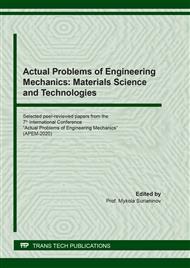[1]
Mandelbrot, B. B. (1982). The Fractal Geometry of Nature. New York–San Francisco: Freeman.
Google Scholar
[2]
Volchuk, V., Klymenko, I., Kroviakov, S. & Orešković, M. (2018). Method of material quality estimation with usage of multifractal formalism. Tehnički glasnik - Technical Journal, 12 (2), 93-97. https://hrcak.srce.hr/202359.
DOI: 10.31803/tg-20180302115027
Google Scholar
[3]
Wang Z. S., Wang L. J. & Su H. L. (2011). Experimental Research on Grading of Fine Aggregate in Frame Concrete. Advanced Materials Research, 163-167, 1085-1089. https://doi.org/10.4028/www.scientific.net/AMR.163-167.1085.
DOI: 10.4028/www.scientific.net/amr.163-167.1085
Google Scholar
[4]
Volchuk, V. M. (2017). On the Application of Fractal Formalism for Ranging Criteria of Quality of Multiparametric Technologies. Metallofizika i Noveishie Tekhnologii, International Scientific and Technical Journal of the Institute of Metal Physics. G.V. Kurdyumov National Academy of Sciences of Ukraine, 39(7), 949-957. (in Russian) https://doi.org/10.15407/mfint.39.07.0949.
DOI: 10.15407/mfint.39.07.0949
Google Scholar
[5]
Bolshakov, V. I., Volchuk, V. M. & Dubrov, Yu. I. (2018). Regularization of One Conditionally III-Posed Problem of Extractive Metallurgy. Metallofizika i Noveishie Tekhnologii, International Scientific and Technical Journal of the Institute of Metal Physics. G.V. Kurdyumov National Academy of Sciences of Ukraine, 40(9), 1165-1171. https://doi.org/10.15407/mfint.40.09.1165.
DOI: 10.15407/mfint.40.09.1165
Google Scholar
[6]
Kroviakov, S., Volchuk, V., Zavoloka, M. & Kryzhanovskyi, V. (2019). Search for Ranking Approaches of Expanded Clay Concrete Quality Criteria. Materials Science Forum, 968, 20-25. https://doi.org/10.4028/www.scientific.net/MSF.968.20.
DOI: 10.4028/www.scientific.net/msf.968.20
Google Scholar
[7]
Zhao, L., Wang, W., Li, Z. & Chen, Y. (2015). Microstructure and pore fractal dimensions of recycled thermal insulation concrete. Materials Testing, 57, 349-359. https://doi.org/10.3139/120.110713.
DOI: 10.3139/120.110713
Google Scholar
[8]
Mishutn, A., Kroviakov, S., Pishev, O. & Soldo, B. (2017). Modified expanded clay light weight concretes for thin-walled reinforced concrete floating structures. Tehnički glasnik -Technical Journal, 11(3), 121-124. https://hrcak.srce.hr/186657.
Google Scholar
[9]
Bolshakov, V., Volchuk, V. & Dubrov, Yu. (2016). Fractals and properties of materials. Saarbrucken, Deutschland: Lambert Academic Publishing.
Google Scholar
[10]
Hausdorff, F. (1919). Dimension und äußeres Maß. Mathematische Annalen, 79, 157-179.
Google Scholar
[11]
Crownover R. M. (1995). Introduction to Fractals and Chaos. Boston, London: Jones and Bartlett Publishers, Inc.
Google Scholar
[12]
Lo, T.Y., Tang, W.C., Cui, H.Z. (2007). The effects of aggregate properties on lightweight concrete. Building and Environment, 42 (8), 3025-3029. https://doi.org/10.1016/j.buildenv. 2005.06.031.
DOI: 10.1016/j.buildenv.2005.06.031
Google Scholar
[13]
Ke, Y., Beaucour, A.L. Ortola, S., Dumontet, H., Cabrillac, R. (2009). Influence of volume fraction and characteristics of lightweight aggregates on the mechanical properties of concrete. Construction and Building Materials, 23 (8), 2821-2828. https://doi.org/10.1016/j.conbuildmat.2009.02.038.
DOI: 10.1016/j.conbuildmat.2009.02.038
Google Scholar
[14]
Bolshakov, V. I., & Dvorkin, L. I. (2016). Structure and Properties of Building Materials. Switzerland: Trans and Technical Publication Ltd.
Google Scholar
[15]
Bolshakov, V. I. & Dubrov, Yu. I. (2002). An estimate of the applicability of fractal geometry to describe the language of qualitative transformation of materials. Journal of Reports of the National Academy of Sciences of Ukraine, 4, 116-121. (in Russian).
Google Scholar
[16]
Bolshakov, V. I. & Volchuk, V. N. (2011). Materials Science Aspects of Using of Wavelet-Multifractal Approach to an Evaluation of Structure and Properties of Low-Carbon Low-Alloyed Steels. Metallofizika i Noveishie Tekhnologii, International Scientific and Technical Journal of the Institute of Metal Physics. G.V. Kurdyumov National Academy of Sciences of Ukraine, 33(3), 347-360.
DOI: 10.15407/mfint.43.06.0753
Google Scholar
[17]
Zeng, Q., Li, K., Fen-Chong, T., Dangla, P. (2010) Surface fractal analysis of pore structure of high-volume fly-ash cement pastes. Applied Surface Science. 257 (3), 762-768 https://doi.org/10.1016/j.apsusc.2010.07.061.
DOI: 10.1016/j.apsusc.2010.07.061
Google Scholar
[18]
Pia, G., Sanna, U. (2013) A geometrical fractal model for the porosity and thermal conductivity of insulating concrete. Construction and Building Materials. 44, 551-556.
DOI: 10.1016/j.conbuildmat.2013.03.049
Google Scholar


